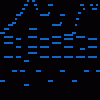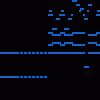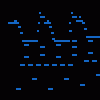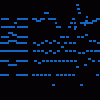Here are some of Chopin's pieces. More wll be added as I transcribe them.
#
TITLE
No comments yet
Chopin - Waltz Op. 64 No. 1 in D♭Major "Minute Waltz"
The Waltz in D-flat major, Op. 64, No. 1, sometimes known as "Valse du petit chien" (French for "Waltz of the puppy"), and popularly known in English as the Minute Waltz, is a piano waltz by Polish composer and virtuoso Frédéric Chopin. It is dedicated to the Countess Delfina Potocka.
The waltz is in the key of D-flat major and has a tempo marking of molto vivace (very lively). Chopin indicates that the waltz is to be played with the sustain pedal used. It is in a simple ternary form, as are many of Chopin's compositions. The A section is marked leggero, and the B section sostenuto. The first consists of the familiar opening melody over standard waltz accompaniment, frequently rising an octave only to drop back down. The second theme is similar, but not identical, and features several broken scales over several octaves between a repeated quarter note and triplet motive. The B section is somewhat calmer, using alternating half and quarter notes over waltz accompaniment. Following a lengthy trill, the A section is repeated, modified only in the ending, which features a three-octave descent instead of a two-octave one.
Camille Bourniquel, one of Chopin's biographers, reminds the reader that Chopin got the inspiration for this waltz as he was watching a small dog chase its tail, which prompted the composer to name the piece Valse du petit chien, meaning "The Little Dog Waltz".
The waltz is in the key of D-flat major and has a tempo marking of molto vivace (very lively). Chopin indicates that the waltz is to be played with the sustain pedal used. It is in a simple ternary form, as are many of Chopin's compositions. The A section is marked leggero, and the B section sostenuto. The first consists of the familiar opening melody over standard waltz accompaniment, frequently rising an octave only to drop back down. The second theme is similar, but not identical, and features several broken scales over several octaves between a repeated quarter note and triplet motive. The B section is somewhat calmer, using alternating half and quarter notes over waltz accompaniment. Following a lengthy trill, the A section is repeated, modified only in the ending, which features a three-octave descent instead of a two-octave one.
Camille Bourniquel, one of Chopin's biographers, reminds the reader that Chopin got the inspiration for this waltz as he was watching a small dog chase its tail, which prompted the composer to name the piece Valse du petit chien, meaning "The Little Dog Waltz".
Comments
No comments yet
Link to this sequence: 3860721
Simple
Advanced
Synthesizer
Instrument name
Copy
Load
Clone
Delete
Mute
Solo
Reset
Volume
Delay
Panning
Detune
Reverb
Distort
Equalizer
High
Mid
Low
Bitcrusher
Synth name
Resonance (Q)
LFO
1/4
Envelope
A
D
S
R
Edit Markers
Settings
BPM
Title
Instrument
- Select/deselect notes
- Select/deselect markers
- Save a copy
- Save offline
- Export MP3
- Export WAV
- Export MIDI
- Import MIDI/Sequence File
- Fast graphics
- Invert
- Minor ⇄ Major
- Reverse Selection
- Humanize Selection
- Legatomize Selection
- Fade In Selection
- Fade Out Selection
- Stretch Selection
0
Connect a MIDI keyboard.
Record keyboard and MIDI inputs.
Snap recorded notes to the grid.
Filter recorded notes using the key guide.
Play a metronome. When recording, gives a 4 beat lead in.
OnlineSequencer.net is an online music sequencer. Make tunes in your browser and share them with friends!
Made by Jacob Morgan and George Burdell
·
Hosting 4,194,554 sequences since 2013 ·
Buy us a ☕ ·
Privacy
·

















